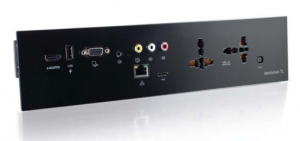Evaluation of TA-8990 Scaler/Extender/Switch
Overview
A Teleadapt TA-8990 was brought to us for testing and evaluation. As a basic overview, this device provides a user connectivity point for a wall or overhead display. For deeper explanation, it is common for presentation and conference rooms to contain computers and appliances necessary for displaying media such as PowerPoint; though it is becoming more common for users to bring their own devices to these spaces. It is inconvenient to dig around behind a wall-mounted flat panel display or stand on a desk to reach a ceiling mounted projector. As a result, AV engineers spend a considerable amount of energy extending the wiring connections of the display devices for end user ease of use. Many devices and methodologies have evolved to assist us in this process; the TA-8990 is one of those.
How It Works
The TA-8990 works by accepting a variety of signals including HDMI, VGA, Composite/Baseband Video, and even an iPod/iPad through a specialized cable. The unit will auto-detect which video source is plugged into it, then switch to that source as the active output. The video is then routed to the single HDMI output for delivery to the room’s display device, thus negating the need to run multiple, expensive cables or purchase displays that have each of the input types this unit supports.
A further cornerstone of the unit is its built in scaler. This feature allows a range of input resolutions to be dropped into the TA-8990. The unit will then adjust the resolution of the input video to an optimized size.
There are also other major features. The TA-8990 has two convenience NEMA 5 plugs (regular old power outlet) and a hardware RJ45 Ethernet port that can be used to pass along a wired network connection for user access. In addition to simply passing along a network connection, the unit also has network management functionality, which allows for systems administration in large-scale deployments. To update the unit, report usage or provide other routine work, technicians do not have to be hands on with the system as they can remotely access it.
Our Evaluation
In our tests, we did find the unit passed the HDMI output of a MacBook Pro seamlessly to our Samsung HD display with no scaling or artifacting of any sort. We determined that it was passively passing the signal, a bonus for those concerned about middleman problems with HDCP. Unfortunately, the same was not true of the VGA port. VGA input was fairly unstable and only supports resolutions up to 1280×1024. Many laptops exceed this resolution already including the MacBook Pro we were using. We also found that the scaler did not handle 16×9 resolutions and it simply failed to output any video at all. While there is a work around for the end user in that they can simply use the resolution adjustment features of their laptop to convert their display, we found that functionality less than optimum. This is, after all, a device to make their connectivity more convenient and user friendly; digging in your settings is not friendly. We also had difficulty using our iPad; the device failed to pass a video signal from it to our TV. The network functionality did perform as expected; the device provided a great wired access point for connectivity while the convenience power outlet performed, as you would expect it to. Lastly, the input sensing and switching of the unit worked perfectly at every point.
The auto input sensing of the unit worked very well and the aggregation of multiple inputs over a single cable is a feature coveted by AV integrators and support technicians who crave simplicity. However, the major weakness of the unit is its lack of support for 16×9 VGA signals and resolutions greater than 1280×1024. The scaler image quality is somewhat lacking as well. The unit would also benefit from a component video input, which would not be difficult to engineer into the piece. That aside, this unit is primarily engineered for the hospitality industry but could be at home in an environment where 1280×1024 projectors are still in use.



